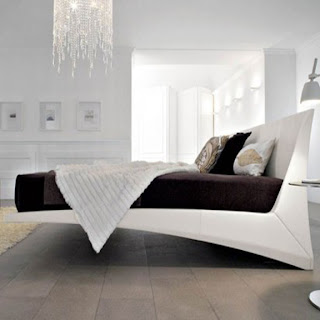The Unity of Opposites
Visually, it is natural for us to separate elements into two categories. Positive and Negative. Depending on what we feel is important and what we feel simply surrounds or fills in the space around the more important elements. Different people can have differing views on what is positive and negative even if they are viewing the same thing. The image I chose is a good example of this because the bed can be considered more important to one person, while another person may perceive the space around it as more interesting.
Defining Space with Horizontal Elements: Depressed Plane
There are several ways in which the horizontal plane on which a space is resting can define the space. If there is simply a horizontal plane laying on a differing background then we get a sense of space, but there are better ways of emphasizing this space. One way is to create a depressed horizontal plane. This may show that attention should be drawn to this one area or it may separate this area for a particular activity. For instance, in the image I chose to use the depressed plane draws attention to the center where there will be performances.
Defining Space with Vertical Elements: L-Shaped Planes
Not only can you define space by manipulating horizontal planes, you can also manipulate vertical planes and walls. Much like the horizontal planes, there are various ways in which these planes can change to make different types of spaces and create different atmospheres. The type of planes I chose to analyze were L-shaped planes. When two planes come together to form an L around a space it creates a sheltering and enclosed feel that is still open and spacious. The image I used is a kitchen which obviously deserves a sheltering feeling because it is well known that the kitchen is the "heart of the home". However, it is still open to adjacent spaces allowing for a social atmosphere.
Qualities of Architectural Space: Light
Technically, all of the qualities of space, such as degree of closure, proportion, and light, play off of each other. The amount of exposure versus closure can
then lead to a change in the amount of light that enters the space. I decided to focus on the light of architectural spaces in my analysis. The illumination of surfaces within a space can play an integral part throughout the space. The image I used is very open, with very little closure. This allows for a large amount of natural light to enter the space along with the artificial light included within the structure. All of these factors lead to a well illuminated space.
Openings in Space-Defining Elements: Within Planes
Openings throughout the planes that make up a space are more important than most people may realize. By creating openings in planes that separate spaces, you are able to create a connection between adjacent spaces that would be nonexistent without openings. Openings can be within the planes, they can be at the corners of a plane, or that lie between planes. I chose to focus on an opening within a plane. The image I decided to use includes a long horizontal opening within a plane that allows for a better panoramic view outside of the window.
About Me

- Paula Cuevas
- My name is Paula Cuevas. I am an Interior Design major at SCAD. SCAD is currently the #1 school for Interior Design in the country. Which probably explains why the work is 1000x harder than what you would expect and the idea of sleep is a luxury. My desire to one day become an innovative and influential designer is what keeps me going. I plan on traveling the world in order to soak up all the different cultures and styles it has to offer. Hopefully, this will enhance my design style even further. My philosophy towards design is that with an OPEN MIND, possibilities become endless.















